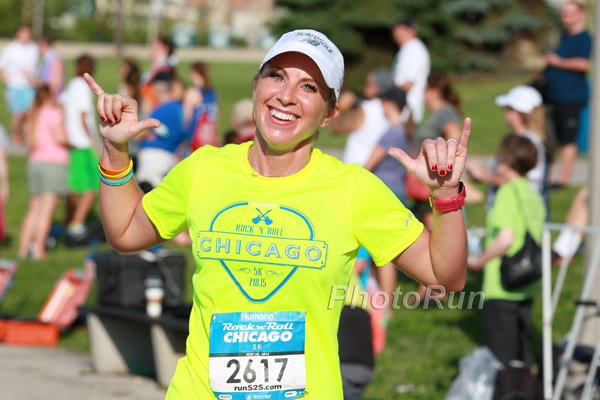Uta’s Yoga and Stabilization Guide for a Better Running Technique
Today, I would like to share with you some insights into my yoga, stretching, and stabilization program. I will explain a few individual exercises, selected from a wide variety, and give examples of effective combinations.
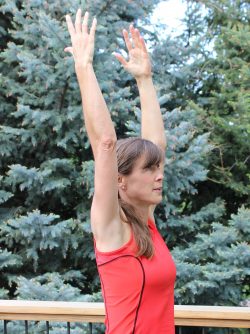
Runners, whether beginners or advanced, can especially benefit from these exercises, improve their running technique, run more efficiently and help prevent injuries.
You may use my suggestions as an introduction to your own personal program. I recommend you start exercising in a group, with a teacher. Trust someone who has enough experience.
The joy of a new fitness routine can give you the positive energy to begin your journey to discover yoga and stabilization. Each exercise has a specific purpose. Since the exact body alignment can be difficult to explain, I suggest that in the beginning you perform the poses very slowly.
Two sessions of 15 to 20 minutes per week are a great start. Later, the number of sessions and pose combinations as well as their level of difficulty can be increased gradually. You can practice yoga as many times as you like. For more information, see the following column: Yoga Pose of the Week.
Start with Mountain, Tree and Downward-Facing Dog Pose
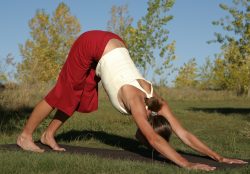
Now, I would like to introduce you to some exercises and pose combinations.
To start, I prefer standing poses. The Mountain pose, I enjoy an extended version see picture above, is ideal for warming up and checking your posture. You feel the connection with the ground and can train your balance. Another is the Tree pose, a classic yoga balance exercise that also increases your concentration and strengthens your foot muscles. From this it goes into the pose of the Downward-Facing Dog, through which you stretch the hamstring, calf muscles and the back, and open up the chest. This is a very effective exercise (asana), as it works multiple structures simultaneously. To be ready for the following exercises, you can also warm up with the popular Sun Salutation.
Stretch Your Hip Flexors
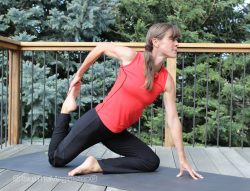
Here is how it works: As you inhale, from the downward-facing dog pose lean forward with your upper body until you feel your shoulders over your wrists, like a push-up. Angle the arms slightly, hold this position while breathing out and in several times. A great stabilization exercise for the core and the shoulders! I like to hold it until my arms start to shake.
Then lower the body to the mat, relax, and from there go into the cobra pose, remembering to place the tops of your feet on the floor. The cobra is strengthening the back muscles and stretches the chest, neck and abdominal muscles. Then go back into the downward-facing dog and from there carefully move into the pigeon pose. My absolute favorite exercise! Why? Because it has great benefits and targets many areas: it supports the stretching of the gluteus and upper hamstring muscles and the hip flexors, and it opens the chest.
After this demanding exercise combination and further poses with stabilization elements, I relax for two to three minutes in the Child’s pose. I breathe deeply, gently stretch the lower back, hips, hip flexor and extensor muscles as well as ligaments of the knee and foot, relax the spine, shoulders and neck. Then, I switch to the exercises on the floor, before the final stabilization.
Hip Extensors are Important too
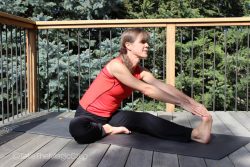
For the next exercise combination I begin sitting with the Head Beyond the Knee pose, stretching the hamstrings and the muscles of the lower back. Incidentally, in addition to improving digestion, this exercise can also help with better sleep. It calms the mind. This is followed by the Spinal Twist, which increases the mobility of the neck, shoulders and spine. Because it stretches the chest and the small muscles between the ribs, lung capacity will be improved as well.
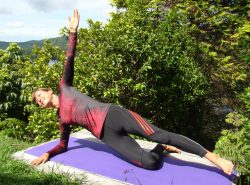
Combining Yoga with Stabilization
After further stretching exercises, I follow with stabilization, beginning with the Bridge pose (see leading picture above), then Side Plank (see picture above) and Forearm Plank (see picture below). This improves the stability of the core and the mobility, strength and functioning of the hamstrings, lower back and hip muscles. These are all important for the running movement.
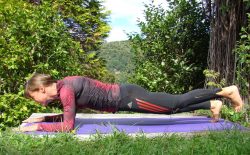
Take your time adding these exercises into your fitness program. And have fun practicing!
Yours,

Adapted from my column “Wie Sie durch diese Übungen Ihre Lauftechnik effektiv verbessern” in the “WELT” with permission (you can read the article in the German language and the entire online “WELT” with a small fee to the newspaper).
*Uta Pippig, 58, is one of the most successful female marathon runners of the ’90s, a three-time champion of the marathons in Boston and Berlin and winner of the NYC Marathon. She is currently a writer and public speaker for “Take The Magic Step®” and “Running to Freedom™” and is also a columnist for the German daily newspaper “DIE WELT” and online “WELT.”
Uta lives in Berlin, Germany, and in Boulder, Colorado, and with her organization “Take The Magic Step®” she commits herself to increasing people’s awareness in the areas of fitness, nutrition and health.
Reading Suggestions:
- Benefits of Yoga
- Listen to Your Body—Stay Healthy and Injury-Free During Your Training
- Yoga for the Right Balance
Updated May 16, 2024
- Posted June 29, 2018
© Copyright 2018-2025 Uta Pippig and Take The Magic Step®. All Rights Reserved.
More Insights
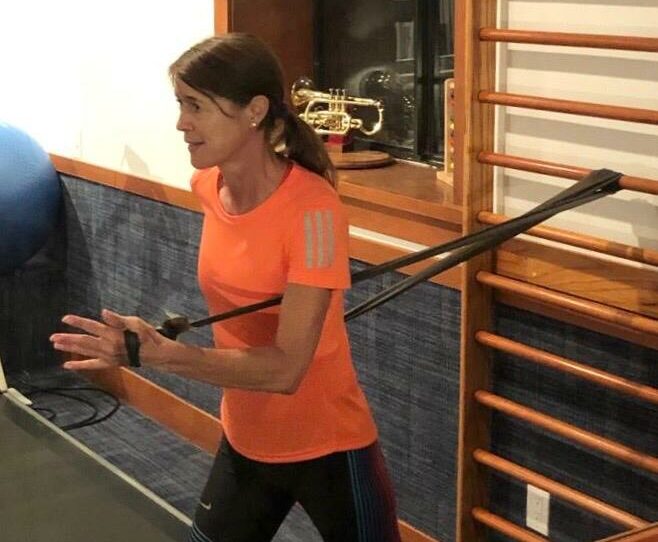
Uta’s Favorite Exercises to Improve Your Fitness and Running Technique
Uta Pippig has designed an at-home fitness program which only uses your own body weight, steps, and a Theraband. They are eight exercises that Uta often does herself.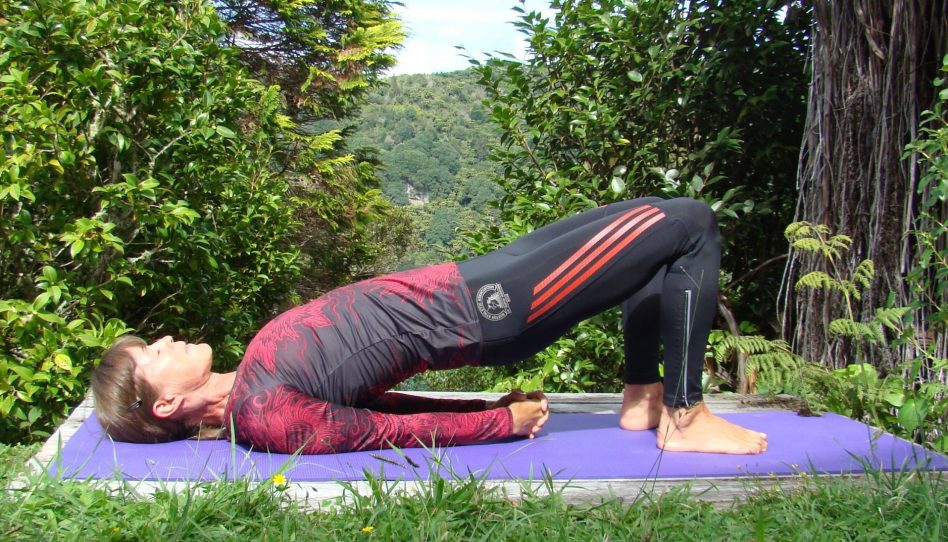
Uta’s Yoga and Stabilization Guide for a Better Running Technique
Runners, especially, can benefit from a well-balanced yoga and stabilization program. Uta suggests effective combinations of poses and exercises that have helped her gain the flexibility and balance that can lead to a better running technique for everyone.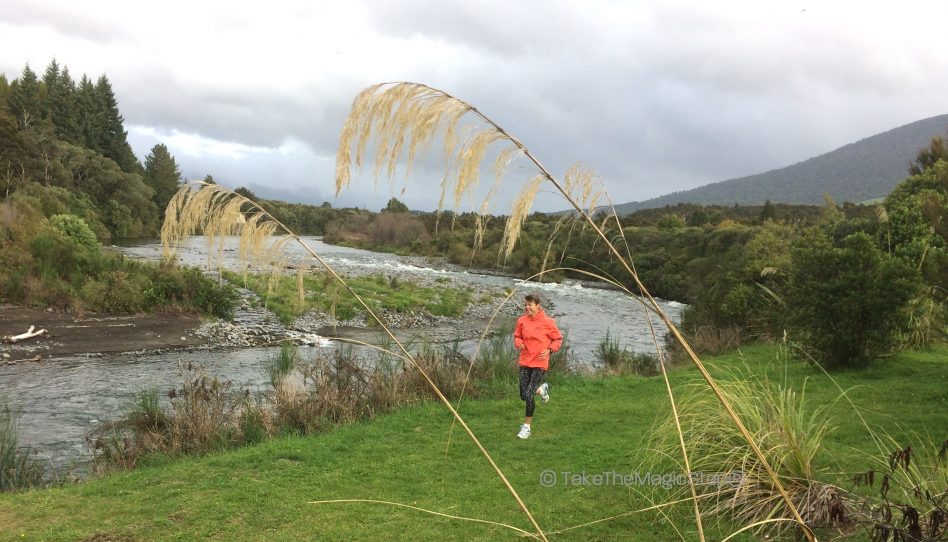
How a Clever Mental Focus Can Get You Through Running Injuries
Running injuries can be devastating, but learning to focus mentally can speed up the healing process. Uta explains how the forced break from running can actually provide future benefits.